Conduct full dematerialization assessments of all current product designs to identify opportunities to minimize material inputs while maintaining product integrity and quality craftsmanship.
Circularity
Learning from Nature's Wisdom
We believe true luxury is rooted in stewardship. Piper & Skye is driven by a deep passion for circularity; a principle that centres around the reduction of waste and regeneration of our planet. We strive to design handbags in such a way as to help heal ecosystems around the globe.
What is Circularity?
To understand circularity we must first acknowledge the shortcomings of the traditional ‘Take-Make-Waste’ economic model that we are trying to move away from. In this model, companies....
1. Take finite resources from the planet
2. Use those resources to make a product
3. Throw away that product as waste at the end of its useful life.
In contrast, a circular business model opts out of this waste-generating cycle by maximizing the usage of non-virgin material inputs, designing products in such a way as to minimize the generation of waste, and aiming to keep products in circulation for as long as possible. The result is the regeneration of planet earth.

How Are We Accomplishing This At Piper & Skye?
Design Out Waste
and Pollution
The handbag design process at Piper & Skye strives to eliminate as much waste and pollution as possible. This is accomplished through careful material selection, innovative design methods that minimize material wastage, and consideration of product end-of-life. Rather than being an inevitable result of production, waste and pollution are viewed as design flaws.
Keep Materials and
Products in Use
Choosing to craft our handbags from pirarucu and alligator (two food by-products) represents our choice to preserve the finite resources of mother earth. Coupling a longevity-focused design process with a one-of-a-kind Repair & Maintenance program guarantees that your Piper & Skye handbag will remain in your rotation for many years to come.
Regenerate
Nature
Piper & Skye strives to ensure that the greatest percentage of raw material inputs come from non-virgin sources. By aiming to source recycled hardware for our handbags, an economic decoupling results between business activity and raw material extraction. Nature does not have to be destroyed to create beautiful handbags

A Circularity Case Study:
Dematerialization of the Braemar Tote
Recognizing the over-construction of our Braemar Tote (i.e. excess use of material inputs), Piper & Skye embarked on its first dematerialization mission. Extensive assessment by the design team found that the internal structural material of the side gussets could be reduced significantly while maintaining the integrity of the bag and its quality craftsmanship. As a result, the second iteration of the Braemar was significantly dematerialized by replacing the heavier structure with a lightweight backing.
Coming Soon...
Carbon Footprint of All Handbags
Recognizing the desire of consumers to have the greatest amount of information about their purchases, Piper & Skye is aiming to be the first luxury handbag company to proudly present the carbon footprint of each one of its handbags. Stay tuned!
Our Circularity Timeline
January 2024: Dematerialization Assessments of Current Products
April 2025: Formalize a Circularity Assessment Process
Develop and implement a corporate policy requiring a standardized circularity assessment be completed on all new product designs before being made available to the public.
June 2026: Launch Repair & Maintenance Program
Launch our Repair & Maintenance Program aimed at extending the useful life of our handbags in order to keep them in circulation longer thereby minimizing post-consumer waste.
July 2026: Define Circularity Metrics and Measurement Methods
Define the metrics that will be used to benchmark the progress we are making towards greater circularity. These metrics will be developed alongside formal monitoring practices and methodologies.
October 2026: Launch Archive Collection
Launch our much anticipated Archive Collection in which unique iterations of handbags, both past and present, are sold as one-off collection pieces.
January 2026: Initiate Circularity Certification Process
Initiate the process of gaining a highly respected circularity certification involving a comprehensive external audit process.
